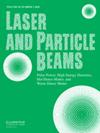激光驱动质子-硼聚变:硼态的影响
IF 1.9
4区 物理与天体物理
Q4 PHYSICS, APPLIED
引用次数: 1
摘要
质子-硼(p11b)反应被认为是先进聚变燃料的圣杯,其中的主反应产生3个高能α粒子。然而,由于高的核束缚能和轫致能量损失,在热聚变条件下,p11b聚变的能量增益很难实现。由于强激光技术的进步,通过使用强激光加速质子束撞击硼-11目标,p11b核聚变引起了新的关注。Labaune等是该领域最具影响力的研究成果之一,他们首先通过实验发现硼的状态(固态或等离子体)对α粒子的产率有重要影响。这个令人兴奋的实验发现激发了在等离子体环境中测量核聚变截面的尝试。然而,到目前为止,仍然没有定量的解释。基于大规模的全动力学计算机模拟,揭示了产量增加的内在物理机制,并给出了定量解释。我们的结果表明,产率的增加是由于质子在简并效应和集体电磁效应的协同作用下减少了能量损失。我们的工作不仅可以作为分析或改进p11b聚变实验的参考,还可以作为研究其他束等离子体系统的参考,例如离子驱动的惯性约束聚变。本文章由计算机程序翻译,如有差异,请以英文原文为准。
Laser-Driven Proton-Boron Fusions: Influences of the Boron State
The proton-boron (p
11
B) reaction is regarded as the holy grail of advanced fusion fuels, where the primary reaction produces 3 energetic
α
particles. However, due to the high nuclear bounding energy and bremsstrahlung energy losses, energy gain from the p
11
B fusion is hard to achieve in thermal fusion conditions. Owing to advances in intense laser technology, the p
11
B fusion has drawn renewed attention by using an intense laser-accelerated proton beam to impact a boron-11 target. As one of the most influential works in this field, Labaune et al. first experimentally found that states of boron (solid or plasma) play an important role in the yield of
α
particles. This exciting experimental finding rouses an attempt to measure the nuclear fusion cross section in a plasma environment. However, up to now, there is still no quantitative explanation. Based on large-scale, fully kinetic computer simulations, the inner physical mechanism of yield increment is uncovered, and a quantitative explanation is given. Our results indicate the yield increment is attributed to the reduced energy loss of the protons under the synergetic influences of degeneracy effects and collective electromagnetic effects. Our work may serve as a reference for not only analyzing or improving further experiments of the p
11
B fusion but also investigating other beam-plasma systems, such as ion-driven inertial confinement fusions.
求助全文
通过发布文献求助,成功后即可免费获取论文全文。
去求助
来源期刊

Laser and Particle Beams
PHYSICS, APPLIED-
CiteScore
1.90
自引率
11.10%
发文量
25
审稿时长
1 months
期刊介绍:
Laser and Particle Beams is an international journal which deals with basic physics issues of intense laser and particle beams, and the interaction of these beams with matter. Research on pulse power technology associated with beam generation is also of strong interest. Subjects covered include the physics of high energy densities; non-LTE phenomena; hot dense matter and related atomic, plasma and hydrodynamic physics and astrophysics; intense sources of coherent radiation; high current particle accelerators; beam-wave interaction; and pulsed power technology.
 求助内容:
求助内容: 应助结果提醒方式:
应助结果提醒方式:


